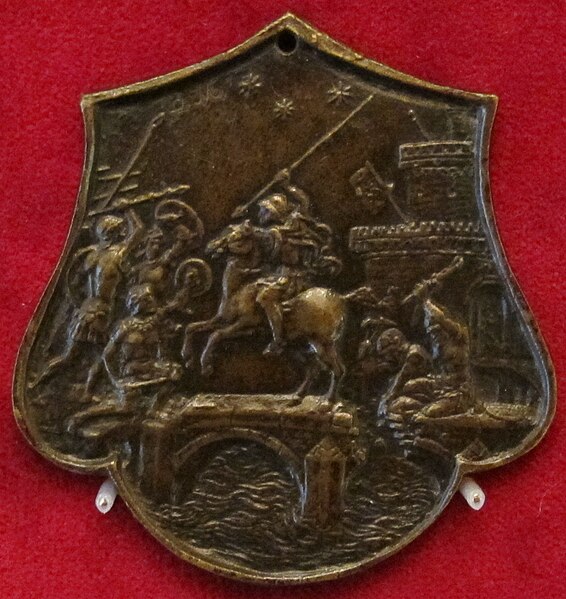A plaquette is a small low relief sculpture in bronze or other materials. These were popular in the Italian Renaissance and later. They may be commemorative, but especially in the Renaissance and Mannerist periods were often made for purely decorative purposes, with often crowded scenes from religious, historical or mythological sources. Only one side is decorated, giving the main point of distinction with the artistic medal, where both sides are normally decorated. They can usually be held within a hand. At the smaller end they overlap with medals, and at the larger they begin to be called plaques. They have always been closely related to the medal, and many awards today are in the form of plaquettes, but plaquettes were less restricted in their subject-matter than the medal, and allowed the artist more freedom.
Horatius Cocles at the bridge, Renaissance plaquette by Master IO.F.F., late 15th century, Padua, 6.1 x 6.0 cm, in a shape for decorating a sword hilt
Peter Flötner, Vanitas, 1535–1540, gilt bronze
Self-portrait head by Leon Battista Alberti, c. 1435, 20.1 cm high
Knight attacked by three lions, Italian, c. 1465
Relief is a sculptural method in which the sculpted pieces remain attached to a solid background of the same material. The term relief is from the Latin verb relevare, to raise. To create a sculpture in relief is to give the impression that the sculpted material has been raised above the background plane. When a relief is carved into a flat surface of stone or wood, the field is actually lowered, leaving the unsculpted areas seeming higher. The approach requires a lot of chiselling away of the background, which takes a long time. On the other hand, a relief saves forming the rear of a subject, and is less fragile and more securely fixed than a sculpture in the round, especially one of a standing figure where the ankles are a potential weak point, particularly in stone. In other materials such as metal, clay, plaster stucco, ceramics or papier-mâché the form can be simply added to or raised up from the background. Monumental bronze reliefs are made by casting.

Side view of Lorenzo Ghiberti's cast gilt-bronze Gates of Paradise at the Florence Baptistery in Florence, Italy, combining high-relief main figures with backgrounds mostly in low relief.
A common mixture of high and low relief, in the Roman Ara Pacis, placed to be seen from below. Low relief background
A low-relief dating to c. 2000 BC, from the kingdom of Simurrum, modern Iraq
"Blocked-out" unfinished low relief of Ahkenaten and Nefertiti; unfinished Greek and Persian high-reliefs show the same method of beginning a work.








